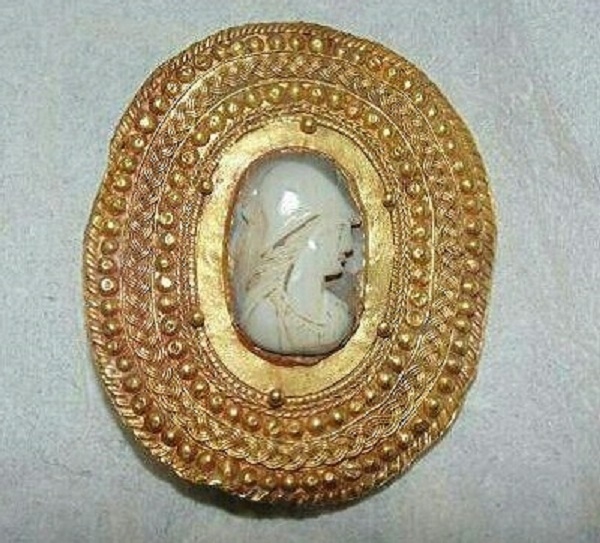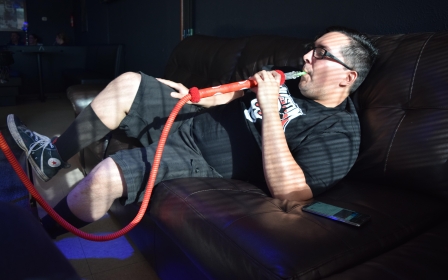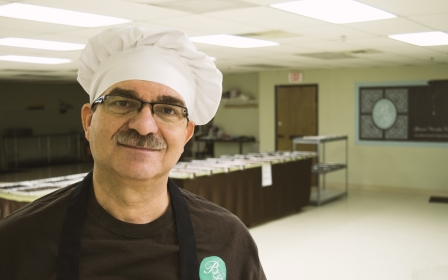‘Art transcends conflict’: Texas artists take on artefact trafficking

AMARILLO, Texas – In the wake of the Arab Spring, the Islamic State (IS) group swept through Iraq and Syria, and the world watched as the Middle East descended into violent chaos.
Countless lives have been lost and many more have been uprooted, resulting in the refugee crisis and the plundering of the cultural heritage of Syria and Iraq – including the infamous destruction of pre-Islamic temples in Palmyra and Nimrod.
Trafficking antiquities is big business, says Andrew Scott Dejesse, who has years of experience tackling the illegal trafficking in artefacts as an officer in the US Army Reserves. The amount of money made from the illicit trade is “three to six billion [dollars], and that’s just a guess,” Dejesse continued.
He would know. Dejesse served as a cultural affairs officer in the US Army Reserves for years before being promoted to the post of cultural preservation officer, the first of his kind. These duties include being a liaison between local populations and the army to help maintain the value of their heritage. Dejesse stressed that he was not speaking as a member of the Army, however.
During one tour in Iraq and two tours in Afghanistan, he came to appreciate the cultural riches of both nations.
The grey market
He hopes to educate buyers on the "grey market". When asked what that means, Dejesse explained that in reference to antiquities, “the black market, meaning things sold illegally, and the legal white market, are so intertwined that it is 'grey'".
The filming of the destruction at Palmyra and other ancient sites seized by IS has more than propaganda value, says Jacob Breeden, an artist in Amarillo who works with Dejesse to raise awareness over antiquities trafficking.
“It’s a smart move on their part. They show footage of cultural heritage being blown up and it makes the value of what’s left increase,” Breeden explains.
Referring to the videos of IS bulldozing and detonating artefacts in territory across the land it occupies, he says: “It’s like when Damien Hirst bought back all of his art to raise its value.” Breeden is referring to the British artist and entrepreneur who purchased his own work back from collector Charles Saatchi.
'These are objects with hundreds or thousands of years of history. At what point do you define that it’s stolen property?'
Breeden and Dejesse have worked together over the past year to create the Collective Heritage Lab (CHL), based in the High Plains city of Amarillo in the deeply conservative, oil-rich Texas Panhandle. The CHL hopes to educate buyers both locally and internationally about the dangers of buying trafficked artefacts from war-torn nations.
Trafficking is a huge issue. In August, the US Department of State imposed emergency import restrictions to protect Syria’s antiquities.
“Preserving the cultural heritage of Syria will be a vital component in shaping a future for the country based on reconstruction, reconciliation, and building civil society,” the release on the import restrictions says.
The CHL has an interdisciplinary approach to the problem. Technology for tracking artefacts will be mixed with media outreach campaigns to shine light on the problem and teach the public. Breeden and Dejesse both say that international laws governing the antiquities market are “without teeth,” due to a lack of mechanisms that validate an object’s origin.
'We can’t stop people from plundering objects from those lands. But we can redirect people to the contemporary works by people from these regions'
“Provenance” is what the antiquities community views as the ideal means of identifying the history and legality of cultural goods. According to the International Foundation for Art Research, provenance details “a documentary record of owners’ names; dates of ownership, and means of transference, i.e. inheritance, or sale through a dealer or auction; and locations where the work was kept, from the time of its creation by the artist until the present day.”
“There’s a limited number of provenanced objects," Dejesse continued. “These are objects with hundreds or thousands of years of history. At what point do you define that it’s stolen property?”
A solid methodology
Another project that deals with the antiquities trade is the Modelling the Antiquities Market in Iraq and Syria (MANTIS), which "builds an innovative multidisciplinary model to estimate the hypothetical value of archaeological material to insurgent groups in Iraq and Syria,” according to its website.
MEE spoke to Oya Topcuoglu, the project’s head researcher in archaeology at the University of Chicago and lecturer at Northwestern University, about the antiquities trade.
While many assume that it is huge frescos and statues being trafficked, that is not the case: “The general assumption is that the market is what you would normally see at big auction houses – Christie's or Sotheby’s for example. The problem with that assumption is that we’re not seeing anything like that on the market,” Topcuoglu said in an interview.
So what is being moved? “Coins for instance, or clay tablets. These are smaller than the palm of your hand. It’s easy for them to put these in their pockets and walk through the border. They’re also very easy to find at an archaeological site,” Topcuoglu continued, “they don’t make a lot of money, but they add up.”
The booming trade is due to a number of factors. Topcuoglu says that demand and lack of awareness are both key. People are often ignorant to the fact that “what they’re buying from a website for a couple of hundreds of dollars is aiding a criminal or terrorist organisation,” the researcher continued.
Topcuoglu hopes that MANTIS’s “solid methodology” will help raise consumer awareness among academics and policy-makers surrounding the legal market.
Uniting the community
Back in Amarillo, CHL’s Dejesse and Breeden say they also want to redirect consumerism towards modern works from those same nations.
“We can’t stop people from plundering objects from those lands. But we can redirect people to the contemporary works – to the people from these regions,” Breeden said.
Part of the motivation behind their desire to do so is to raise cultural awareness about the recent population changes to CHL's hometown.
'We asked ourselves, how we can introduce their forms of cultural expression? Expression as an artistic term – basket weaving, drawing, painting, it’s what we do as humans'
According to some reports, Amarillo has the highest per capita refugee population of any city in Texas. It’s not much – roughly 1.3 percent according to local media reports, but their arrival has caused outrage in the conservative community.
The refugees come from Iraq, Somalia, Burma, Afghanistan, Iran and elsewhere. Throughout the city, neighbourhoods feature signs in many different languages.
“But many people in this town don’t know a thing about [the refugees’] cultures. So, we asked ourselves, how we can introduce their forms of cultural expression? Expression as an artistic term – basket weaving, drawing, painting, it’s what we do as humans.”
At the beginning of November, CHL hosted an exhibit of art from contemporary Afghan artists titled “Art Transcending Conflict.” Currently, the exhibit is in Washington, DC.
“The fact that Amarillo is the first city to get this exhibit after DC makes me very proud,” Dejesse said.
He was deeply affected by the people, landscapes and culture of Iraq and Afghanistan, where he toured with the army. An artist himself, Dejesse often paints realist scenes from Afghanistan.
Dejesse personally values the culture of these countries greatly, and he hopes CHL will help him share their beauty with others. “If you can elevate the value of their culture, it’ll lead to protection and preservation,” he concluded.
New MEE newsletter: Jerusalem Dispatch
Sign up to get the latest insights and analysis on Israel-Palestine, alongside Turkey Unpacked and other MEE newsletters
Middle East Eye delivers independent and unrivalled coverage and analysis of the Middle East, North Africa and beyond. To learn more about republishing this content and the associated fees, please fill out this form. More about MEE can be found here.







